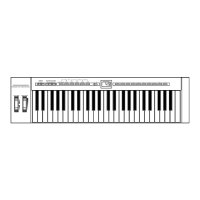
Do you have a question about the Evolution MK-149 and is the answer not in the manual?
Details on powering the unit using 6 "C" size batteries, including installation and best practices.
Instructions for powering the unit via an AC adapter, specifying voltage and current requirements.
Guidance on connecting the MIDI keyboard to other MIDI devices like sound modules or computers.
Steps to turn on the MIDI keyboard and any connected MIDI equipment in the correct sequence.
Instructions to move the WHEEL away from the unit to increase pitch.
Instructions to move the WHEEL towards the unit to decrease pitch.
Procedure to assign various MIDI functions (0-132) to the control WHEEL for custom performance.
Allows shifting the unit's pitch in semitones, up or down, for expressive playing.
Enables shifting the keyboard's pitch up by two octaves or down by one octave.
How to send MIDI PROGRAM CHANGE messages (0-127) using program and numeric keys.
Instructions to send MIDI BANK MSB and LSB messages (0-127) for sound selection.
Procedure to store PROGRAM CHANGE, BANK LSB, and MSB to numeric keys for recall.
Guide to select one of 10 VELOCITY CURVES to alter key-hit response.
